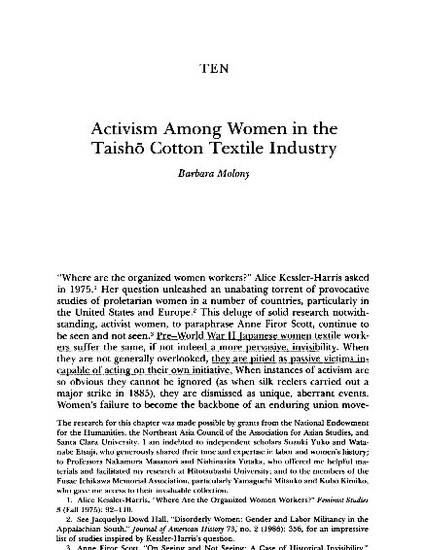
"Where are the organized women workers?" Alice Kessler-Harris asked in 1975.1 Her question unleashed an unabating torrent of provocative studies of proletarian women in a number of countries, particularly in the United States and Europe.2 This deluge of solid research notwithstanding, activist women, to paraphrase Anne Firor Scott, continue to be seen and not seen.3 Pre-World War II Japanese women textile workers suffer the. same,...if not indeed a more pervasive, invisibility. When they are not generally overlooked, they are pitied as passive victims incapable of acting on their own initiative. When instances of activism are so obvious they cannot be ignored (as when silk reelers carried out a major strike in 1885), they are dismissed as unique, aberrant events. Women's failure to become the backbone of an enduring union movement confirms the conventional view of them as passive. Their gender, it is argued-or, as one scholar suggests, their youth4-made them hard to organize.
Further research on women's collective action should modify this assertion. Even if the focus on collective action is limited to institutionalized, organized activism (that is, unions), we must ask whether structural factors like the organization of the factory itself or attitudinal factors like the hostility of male unionists, and not women's "nature" or "culture," explain the lower rate of female participation. Louise Tilly argues persuasively that proletarian women's lower rate of participation in collective action in nineteenth-century France needs "no special psychological or gender-attribute explanation": that is, a similar set of conditions may be used to predict men's and women's propensity to activism. 5 Societal constraints, restrictions by management on the economic independence of female workers, and, in certain circumstances, the workers' own views of what was appropriate behavior for women may have slowed female labor organization in Japan; yet when conditions for activism existed women workers responded.
The question of activism, however, should not be limited to formal political or union actions. This chapter attempts to expand the definition of the term "activism" to connote the opposite of passivity. Thus, activism manifested itself as much in the decisions of rural Japanese women and girls to enter employment in the cotton textile industry as in their collective actions as workers. To understand why farm women would be motivated to enter the mills, one must examine general attitudes regarding appropriate behavior for women in the 1920s. To be sure, what women saw as suitable for themselves as women was itself in a state of evolution. As Teresa de Lauretis notes, "Self and identity ... are always grasped and understood within particular discursive configurations. Consciousness is never fixed, never attained once and for all because discursive boundaries change with historical conditions."6 The converse is equally true: women's contributions to the definition of gender helped produce shifts in their historical context.
